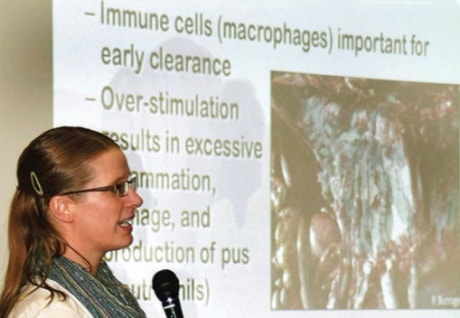Is it the bison or is it the bug?
Much is still unknown about how the pathogen disease M. Bovis affects bison, which is in a way very different from its effects on cattle. And because of the nature of the bison, learning opportunities are challenging.
At the 2013 Wildrose Bison Convention, Show and Sale, Dr. Claire Windeyer of the University of Calgary spoke on the differences the bacteria has on cattle and bison.
“It’s been a pathogen we’ve known about for a long time in cattle, so we know more about it there,” explained Windeyer.
M. Bovis is a bacteria with no cell wall, making it more difficult to treat medicinally or naturally with the immune system.
It can cause respiratory disease, infections of the middle ear, mastitis, arthritis and pink eye.
Within dairy cows udder to udder transmissions occur. Calves can also become infected with M. Bovis through milk and milk supplements.
Within bison the bacteria can also cause abortions.
It colonizes on mucal surfaces, such as the nose, udder and reproductive tract. The bacteria can persist in these areas and producers end up with asymptomatic carriers, which can then introduce the bacteria to the herd.
Asymptomatic carriers can sometimes shed the bacteria for years and shedding can begin if an animal is stressed, transported or comingled.
Windeyer said M. Bovis is a major cause of mortality in feedlots. “One study reported 28 per cent of their mortalities were M. Bovis and 46 per cent of the M. Bovis pneumonias may have arthritis.”
It’s been found non-stressed cattle calves show low numbers of the bacteria but once stressed there may be high levels, even if there are no clinical signs.
According to Windeyer 90 per cent of dairy calves in a herd with M. Bovis issues also have the disease. “If it’s there it’s spreading.”
Because it lacks a cell wall, the image of M. Bovis is consistently changing to the body and antibiotics. Windeyer named several antibiotics that may have an effect on the disease and Draxxin was the only one labeled for Canada.
“I obviously don’t need to tell bison producers there isn’t much labelled for bison,” she added. “In terms of mastitis, people have kind of given up on treating them and just recommending helming if you have mastitis.”
With cattle, early detection and treatment is recommended, but with bison that presents challenges.
Windeyer says it’s harder to get a sense of clinical cases because bison herds aren’t managed and checked like cattle. Also common diagnostic tests for cattle don’t work as well on bison and they are able to hide their symptoms until the disease is quite advanced.
Since bison are such herd animals, Windeyer feels nose to nose transmission of M. Bovis is a key way the disease spreads through a herd.
What is unknown about M. Bovis in bison is how common or widespread it is.
“We don’t really understand why the presentation in the disease is so different. So why is this killing 20 per cent of mature cows out on grass, no stress. When in cattle, typically we’re looking at young animals in stress.”
The disconnect between the two species prompts her biggest question: Is the bison or is it the bug?
